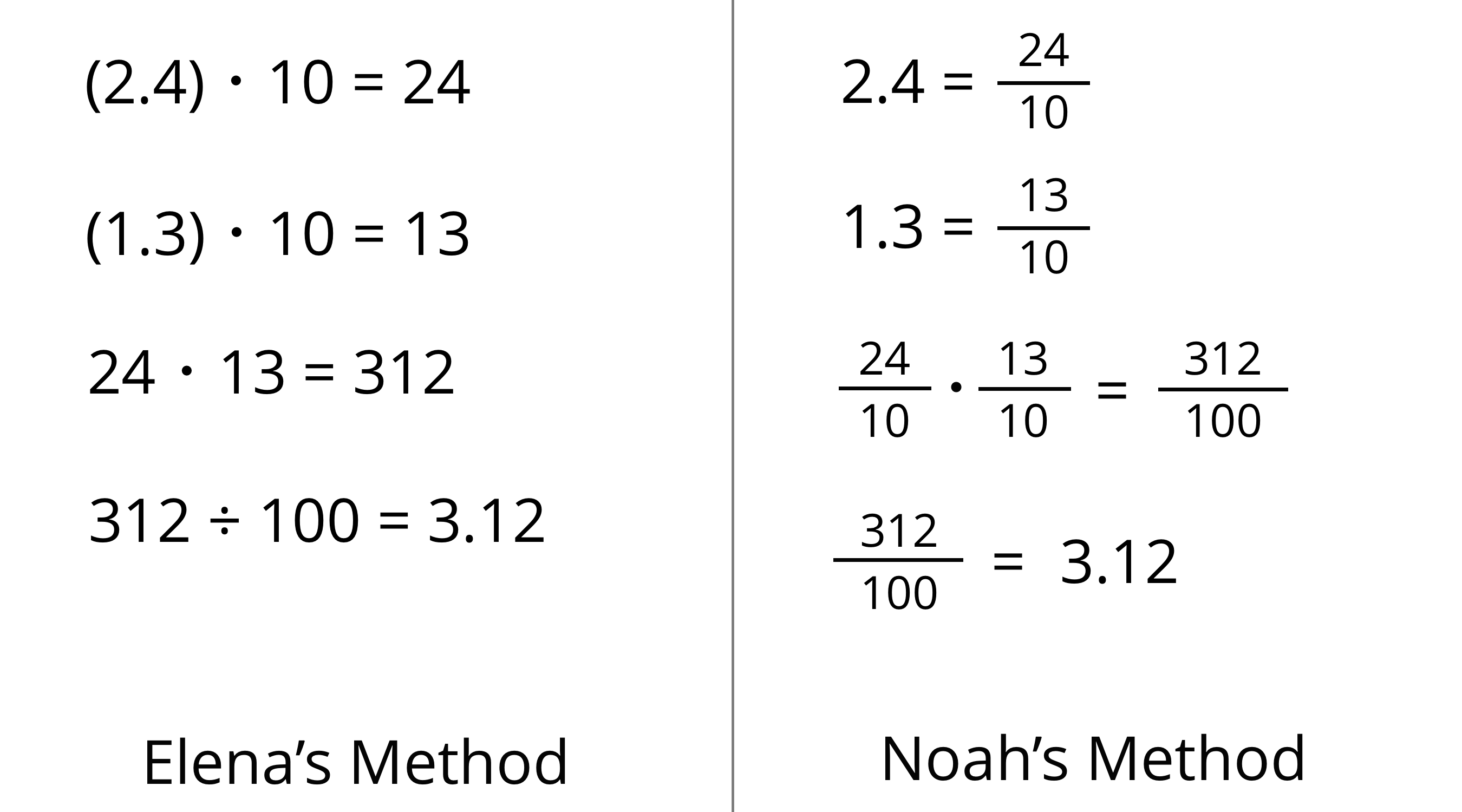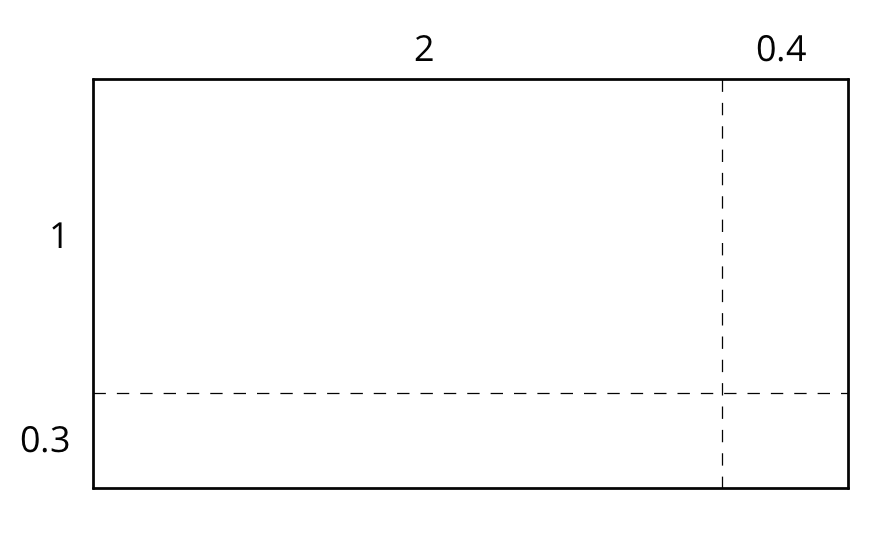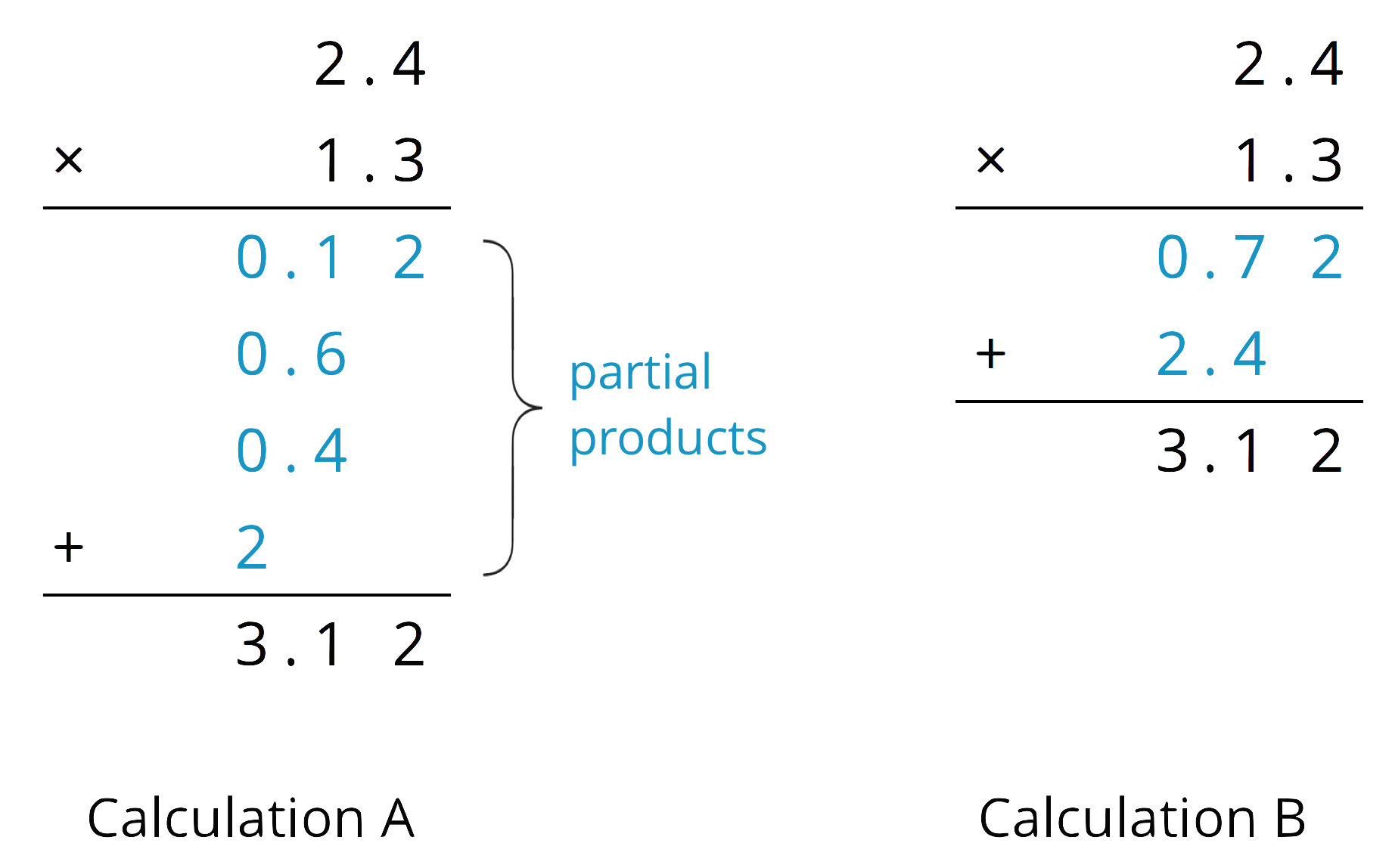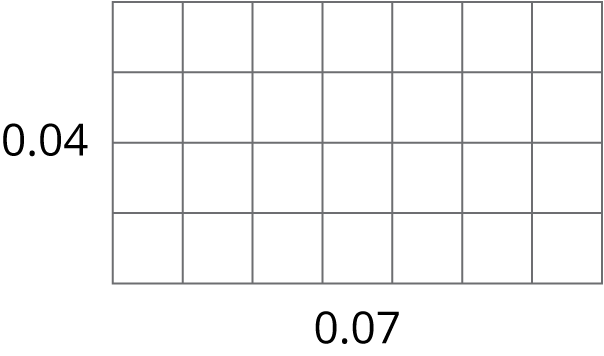Lesson 16
Methods for Multiplying Decimals
16.1: Multiplying by 10
-
In which equation is the value of \(x\) the largest?
\(x \boldcdot 10 = 810\)
\(x \boldcdot 10 = 81\)
\(x \boldcdot 10 = 8.1\)
\(x \boldcdot 10 = 0.81\)
-
How many times the size of 0.81 is 810?
16.2: Fractionally Speaking: Multiples of Powers of Ten
-
Select all expressions that are equivalent to \((0.6) \boldcdot (0.5)\). Be prepared to explain your reasoning.
- \(6 \boldcdot (0.1) \boldcdot 5 \boldcdot (0.1)\)
- \(6 \boldcdot (0.01) \boldcdot 5 \boldcdot (0.1)\)
- \(6 \boldcdot \frac{1}{10} \boldcdot 5 \boldcdot \frac{1}{10}\)
- \(6 \boldcdot \frac{1}{1,000} \boldcdot 5 \boldcdot \frac{1}{100}\)
- \(6 \boldcdot (0.001) \boldcdot 5 \boldcdot (0.01)\)
- \(6 \boldcdot 5 \boldcdot \frac{1}{10} \boldcdot \frac{1}{10}\)
- \(\frac{6}{10} \boldcdot \frac{5}{10}\)
-
Find the value of \((0.6) \boldcdot (0.5)\). Show your reasoning.
-
Find the value of each product by writing and reasoning with an equivalent expression with fractions.
- \((0.3) \boldcdot (0.02)\)
- \((0.7) \boldcdot (0.05)\)
Ancient Romans used the letter I for 1, V for 5, X for 10, L for 50, C for 100, D for 500, and M for 1,000. Write a problem involving merchants at an agora, an open-air market, that uses multiplication of numbers written with Roman numerals.
16.3: Using Properties to Reason about Multiplication
Elena and Noah used different methods to compute \((2.4) \boldcdot (1.3)\). Both calcuations were correct.

-
Analyze the two methods, then discuss these questions with your partner.
- Which method makes more sense to you? Why?
- What might Elena do to compute \((0.16) \boldcdot (0.03)\)? What might Noah do to compute \((0.16) \boldcdot (0.03)\)? Will the two methods result in the same value?
-
Compute each product using the equation \(21 \boldcdot 47 = 987\) and what you know about fractions, decimals, and place value. Explain or show your reasoning.
- \((2.1) \boldcdot (4.7)\)
- \(21 \boldcdot (0.047)\)
- \((0.021) \boldcdot (4.7)\)
16.4: Connecting Area Diagrams to Calculations with Decimals
- You can use area diagrams to represent products of decimals. Here is an area diagram that represents \((2.4) \boldcdot (1.3)\).

-
Find the region that represents \((0.4) \boldcdot (0.3)\)? Label that region with its area of 0.12.
-
Label each of the other regions with their respective areas.
-
Find the value of \((2.4) \boldcdot (1.3)\). Show your reasoning.
-
-
Here are two ways of calculating 2.4 times 1.3.

Analyze the calculations and discuss with a partner:
- In Calculation A, where does the 0.12 and other partial products come from? In Calculation B, where do the 0.72 and 2.4 come from? How are the other numbers in blue calculated?
- In each calculation, why are the numbers in blue lined up vertically the way they are?
-
Find the product of \((3.1) \boldcdot (1.5)\) by drawing and labeling an area diagram. Show your reasoning.
-
Show how to calculate \((3.1) \boldcdot (1.5)\) using numbers without a diagram. Be prepared to explain your reasoning. If you are stuck, use the examples in a previous question to help you.
-
Use the applet to verify your answers and explore your own scenarios. To adjust the values, move the dots on the ends of the segments.
How many hectares is the property of your school? How many morgens is that?
Summary
Here are three other ways to calculate a product of two decimals such as \((0.04) \boldcdot (0.07)\).
-
First, we can multiply each decimal by the same power of 10 to obtain whole-number factors.
Because we multiplied both 0.04 and 0.07 by 100 to get 4 and 7, the product 28 is \((100 \boldcdot 100)\) times the original product, so we need to divide 28 by 10,000.
\(\displaystyle (0.04) \boldcdot 100 = 4\)
\(\displaystyle (0.07) \boldcdot 100 = 7\)
\(\displaystyle 4 \boldcdot 7=28\)
\(\displaystyle 28\div 10,\!000=0.0028\)
-
Second, we can think of \((0.04) \boldcdot (0.07)\) and 4 hundredths times 7 hundredths and write:
\(\displaystyle \left(4 \boldcdot \frac {1}{100}\right) \boldcdot \left(7 \boldcdot \frac {1}{100}\right)\)
We can rearrange whole numbers and fractions:
\(\displaystyle (4 \boldcdot 7) \boldcdot \left( \frac {1}{100} \boldcdot \frac {1}{100}\right)\)
This tells us that \((0.04) \boldcdot (0.07) = 0.0028\).
\(\displaystyle 28 \boldcdot \frac {1}{10,\!000} = \frac {28}{10,\!000}\)
-
Third, we can use an area model. The product \((0.04) \boldcdot (0.07)\) can be thought of as the area of a rectangle with side lengths of 0.04 unit and 0.07 unit.

In this diagram, each small square is 0.01 unit by 0.01 unit. The area of each square, in square units, is therefore \(\left(\frac{1}{100} \boldcdot \frac{1}{100}\right)\), which is \(\frac{1}{10,000}\).
Because the rectangle is composed of 28 small squares, the area of the rectangle, in square units, must be: \(\displaystyle 28 \boldcdot \frac{1}{10,000} = \frac{28}{10,000}=0.0028\)